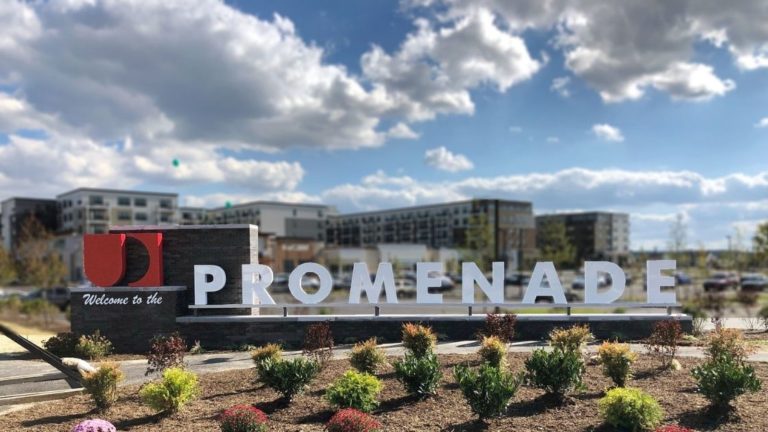Private developers and public officials are pushing back against Montgomery County’s residential construction process, Bisnow.com reported earlier this month.
According to their coverage, new construction and housing affordability is often caught behind “bureaucratic hurdles”. Montgomery County Commissioner Thomas DiBello told Bisnow that the county’s red tape can be excessive, and Commissioner Jamila Winder said rising housing prices, high demand, and “exorbitant costs” to develop are keeping people from buying local properties.
Among the challenges to new developments are community pushback involving parking, traffic, and impact on local school districts, among other concerns, Bisnow said. A Philadelphia developer referred to borough officials as “gatekeepers” and said they should be incentivized “to prioritize density and new construction.”
The article makes mention of the Promenade at Upper Dublin (1100-1135 Market Street in Dresher), which includes a 25-acre mixed use community with retail stores, restaurants, and high-end apartments. It also mentions Ambler’s forthcoming SEPTA mixed-use project that could bring up to 170 multifamily residential units to the site.
In February, CBS News reported on the nationwide affordable housing shortage, and highlighted Norristown’s the Preserve at Stony Creek, a forthcoming 68-acre neighborhood which will include 453 townhomes and 288 apartment units.
Glenside Local reached out to local public officials for additional insight. The following was provided via email by Jenkintown borough manager George Locke:
What are the main considerations that go into approving/rejecting a housing development proposal?
That the plans will or can comply with Zoning and Land Development requirements. That the project would fit with the neighborhood character. Accessibility improvements. That the project is safe and will not negatively affect the health & welfare of the current and future residents.
Is the township more or less likely to approve a housing development plan compared to 20 years ago?
While I was not working for the Borough 20 years ago, I can tell you there are more development approvals over the second half of my 14 years with the Borough than the first half of my time here. Why? Our Zoning Code was adopted in 2010, and our Sub-Division and Land Development Ordinance was adopted in 2023. Having these updated codes clearly define the requirements for a project and allows applicants to have a guide of what will be needed on their plans to gain approval. The Professionals who reside in the Borough and volunteer their time/services on Council as well as the various Committees and Commissions to assist in the process. The desire to lessen the tax liability on current residents and commercial property owners. Our Borough has invested in the sanitary sewer system and is no longer under a sewer moratorium for new connections.
What are the most common concerns community residents share when a new development is being considered (i.e. traffic, parking, etc.)?
Some community members voice concern about the developments possibility of bringing to many students to the small school district. Other concerns are of parking, traffic, building character, storm water and green space.
Cheltenham Township responded via email with the following:
What are the main considerations that go into approving/rejecting a housing development proposal?
Housing development projects are required to submit applications for review by the Township, which include but are not limited to, reviews for compliance with the Township’s Zoning, Subdivision and Land Development, and Stormwater Ordinances. If a development is not consistent with the requirements of an ordinance, an applicant may amend its application to meet the requirements or seek relief through a zoning variance, special exception, or land development waiver. Projects are reviewed by Township staff and consultants who specialize in areas of traffic planning, engineering, stormwater management, etc., then they are presented, as required, through a public process with the Township’s Planning Commission, Zoning Hearing Board, Shade Tree Advisory Commission, Board of Historical and Architectural Review, committees of the Board of Commissioners, and finally for review and vote by the Board of Commissioners. Outside review agencies, such as the Montgomery County Planning Commission, Montgomery County Conservation District, Pennsylvania Department of Environmental Protection, PennDOT, and Aqua, also have an opportunity to weigh in on a proposal to ensure that it meets their own sets of requirements. – Township Manager Alyson Elliott
Sewer capacity and availability also plays a role in the process. This is something the developer also has to take into consideration and factor into their timelines, as this process could take longer than 18 months. Developers have to act quickly upon approval of their sewer capacity, taking into consideration that not applying the allocated sewer towards the development in a timely manner takes away from development or redevelopment in the community related to other tax ratable commercial uses. – Henry Sekawungu, Director of Planning & Zoning
Is the township more or less likely to approve a housing development plan compared to 20 years ago? Why?
The Township, like many municipalities, reviews proposals in accordance with the Pennsylvania Municipalities Planning Code. If a project is lawfully submitted to the Township and meets applicable ordinance requirements, it will be approved. – Township Manager Elliott
What are the most common concerns community residents share when a new development is being considered (i.e. traffic, parking, etc.)?
Cheltenham Township residents are active in providing input on proposed developments. Resident concerns are often situation based. For some residents, the potential for a development’s impact on traffic is a concern, while stormwater is a concern for other residents. Density is often a broader concern, mostly because of its impact on traffic, stormwater and schools. – Township Manager Elliott


Efforts are being made. In June 2024, Montgomery County launched an advocacy and informational resource website, Homes for All, to help residents find affordable housing availabilities. At that time, the median sales price for a house in Montgomery County was $450,000 and average rent for a two-bedroom apartment was $1,886 per month, which is 60% higher than the Pennsylvania average.
In March, the state allotted $9,162,521 to the Montgomery County Office of Housing and Community Development for several projects, including $3,635,00 for new multi-family rental construction to replace lost rental units due to Hurricane Ida, and $3,635,000 for housing rehabilitation projects.
In September 2024, Governor Josh Shapiro of Abington signed an Executive Order mandating Pennsylvania’s first comprehensive Housing Action Plan to address the state’s housing shortage, homelessness, and expand affordable housing options. In October 2024, October, the Shapiro Administration announced the launch of the new $10 million PA Mixed-Use Housing Development pilot program to develop mixed-use projects with a residential housing component.
Shapiro’s 2025-26 budget proposal calls for “significant investments to restore and modernize our aging housing stock with a new $50 million investment to create a statewide housing repair fund to help homeowners struggling to make needed repairs to their aging homes,” a statement said. “The budget also includes $1 million in dedicated funding to the State Planning Board to help municipalities with growth-oriented housing policies.”
On July 7, Abington Township announced that it was awarded 2025 PHARE funds to support mobility and housing accessibility for seniors. The press release is below:
For all the latest news, follow us on Facebook or sign up for Glenside Local’s “Daily Buzz” newsletter here.

